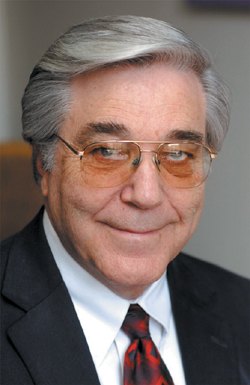
Billy Hudson, Ph.D.
Hudson’s kidney research honored by nephrology society
After 30 years of crafting questions and finding their answers, Billy Hudson’s research is as integral to nephrology as the molecular matrices he studies are to kidney function. Tomorrow, the American Society of Nephrology will acknowledge Hudson the man, aside from his benchwork, with the Homer W. Smith Award.
The award is the ASN’s highest honor, presented each year to an individual whose lifetime scientific contributions have led to the understanding of kidney function and, especially, dysfunction.
“He really has been one of the pioneers working on the biochemistry of basement membranes in the glomeruli of the kidney [the micro-filtering units responsible for kidney function],” said Dr. Peter Aronson, a past awardee and a professor of Cellular and Molecular Physiology at Yale.
Billy Hudson, Ph.D., the Elliot V. Newman Professor of Medicine and founder and director of the Center for Matrix Biology at Vanderbilt, will accept the award tomorrow at the ASN’s annual meeting in San Diego on behalf of more than 60 students and fellows from 24 countries.
For three decades, Hudson’s laboratory, first at Oklahoma State University, then Kansas University Medical Center and, since just last year at Vanderbilt, have shaped and formed the study of basement membranes, the study of matrix material that binds cells and influences their function.
They discovered the alpha 3 and alpha 4 chains of type IV collagen — strands of protein that organize the basement membrane in the kidney and which are defective in Alport’s syndrome. They also discovered that alpha 3 is responsible for triggering the autoimmune disease Goodpasture’s syndrome and kidney rejection in some patients with Alport’s syndrome.
“Billy is a great asset to young investigators in the department because he has a friendly and approachable personality,” said Dr. Eric G. Neilson, Morgan Professor and Chairman of the Department of Medicine. “He has the ability to ask good biologic questions about important biomedical problems. This award recognizes all of that.”
Most recently, Hudson’s work identified exactly where alpha 3 connects to other molecules within the basement membrane. He co-founded BioStratum, a biotechnology company that is developing a drug, Angiocol, to disable those connections and inhibit the growth and spread of tumors. It has been accepted by the FDA for clinical trials.
The company’s leading drug candidate, Pyridorin, has completed phase II clinical trials for diabetic kidney disease. It has been given fast-track status by the Food and Drug Administration.
Hudson credits the guidance of trusted advisors with fueling and shaping his career. “They taught me the power of crafting a simple, direct question, and the importance of rigor in experimentation as a basis for discovery. Most of my work has been spent trying to figure out the right question, rather than making observations.”
Several key questions in his career, he said, have been: What is the molecular target for the Goodpasture's auto-antibodies? How is it organized in the tissues? What is its atomic structure? And, how does it trigger autoimmune disease?
One of Hudson’s early collaborators, Dr. Jared Grantham, a past awardee and a University Distinguished Professor and director of the Kidney Institute at the University of Kansas, said Hudson is a rare bench researcher.
“He wants to work in a venue with a strong clinical emphasis because he wants his work to amount to something at the end of the day,” Grantham said. “He’s a basic scientist, but he wants his work to relate to human disease. That’s an unusual quality to have in a basic research scientist, someone who is keenly aware of his research and its relevance to potentially relieve human suffering.
“There will be a lot of clinicians in the audience who will be very surprised about his approach to science and how it works so beautifully to improve our understanding of how the diseases (Goodpasture’s and Alport’s syndromes) damage the kidneys, as well as giving new insights into how they might be treated,” Grantham added.
Ten years ago, two former students challenged Hudson to translate his basic science into medicine.
“I said, ‘I don’t think that way. I’m interested in understanding how things work, not how to fix them,’” he said.
But once he applied himself to that end, he said, “It was like taking a sabbatical. It opened our minds to the many possibilities of our work. When we write grants we all say that our research might lead to a drug,” he said dismissively. “But as it turns out, due to the dedicated efforts of my previous students, our work has actually translated into several drug candidates.
Hudson hasn’t forgotten two patients who made his research possible: Linda Langley, the Goodpasture’s syndrome patient whose blood was key in discovering the cause of this disease, and Douglas Strickland, whose blood helped Hudson answer questions about Alport’s syndrome.













